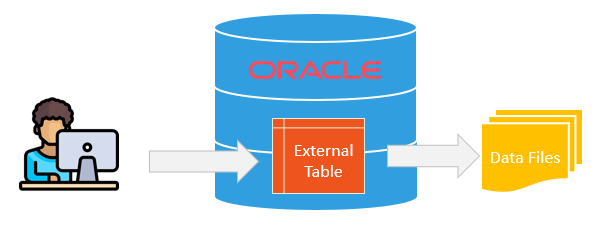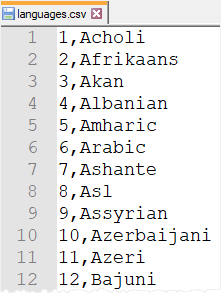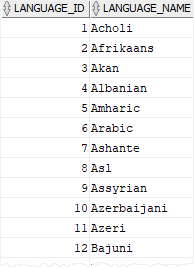Summary: in this tutorial, you will learn about Oracle external tables that allow you to access data in flat files as if it were in tables.
What is an Oracle external table
An external table is a table whose data come from flat files stored outside of the database.
Oracle can parse any file format supported by the SQL*Loader.
Why do you need to use external tables
The external tables can be useful in the ETL process of data warehouses because the data does not need to be staged and can be queried in parallel.
Notice that you should not use external tables for frequently accessed tables.
Creating an Oracle external table steps
You follow these steps to create an external table:
- First, create a directory which contains the file to be accessed by Oracle using the
CREATE DIRECTORYstatement. - Second, grant
READandWRITEaccess to users who access the external table using theGRANTstatement. - Third, create the external table by using the
CREATE TABLE ORGANIZATION EXTERNALstatement.

Creating an Oracle external table example
Here is a CSV file that has two columns: language id and name.

Download the languages.csv file
We will create an external table that maps to the languages.csv file.
1) Create a directory object
First, place the language.csv file in the C:\loader directory.
Second, log in to the Oracle database using the sysdba user via the SQL*Plus program:
Enter user-name: sys@pdborcl as sysdba
Enter password: <sysdba_password>Code language: JavaScript (javascript)Third, create a new directory object called lang_external that maps to the C:\loader directory:
SQL> create directory lang_external as 'C:\loader';
<pre class="lang:plsql decode:true "></pre>Code language: JavaScript (javascript)2) Grant READ and WRITE access on the directory object to users:
The following statement grant READ and WRITE privileges to the OT user:
SQL> grant read,write on directory lang_external to ot;
Grant succeeded.Code language: SQL (Structured Query Language) (sql)3) Creating the external table
Use the CREATE TABLE ORGANIZATION EXTERNAL statement to create the external table called languages:
CREATE TABLE languages(
language_id INT,
language_name VARCHAR2(30)
)
ORGANIZATION EXTERNAL(
TYPE oracle_loader
DEFAULT DIRECTORY lang_external
ACCESS PARAMETERS
(FIELDS TERMINATED BY ',')
LOCATION ('languages.csv')
);
Code language: SQL (Structured Query Language) (sql)When you create the external table using the CREATE TABLE ORGANIZATION EXTERNAL statement, you need to specify the following attributes:
TYPE
The TYPE determines the type of the external table. Oracle provides two types: ORACLE_LOADER and ORACLE_DATADUMP:
- The
ORACLE_LOADERaccess driver is the default that loads data from text data files. Technically speaking, theORACLE_LOADERloads data from an external table to an internal table. However, it cannot unload the data i.e., it cannot move data from the internal table to the external table. - The
ORACLE_DATAPUMPaccess driver can perform both loads and unloads. It requires the data in the binary dump file format.
DEFAULT DIRECTORY
The DEFAULT DIRECTORY clause allows you to specify the default directory for storing all input and output files. It accepts a directory object, not a directory path.
ACCESS PARAMETERS
The ACCESS PARAMETERS clause allows you to describe the external data source. Note that each access driver has its own access parameters.
LOCATION
The LOCATION clause specifies the data files for the external table.
You specify the data file in the form directory:file. If you omit the directory part, Oracle uses the DEFAULT DIRECTORY for the file.
Using an Oracle external table
Once the external table is created, you can query it like a normal table:
SELECT
language_id,
language_name
FROM
languages
ORDER BY
language_name;
Code language: SQL (Structured Query Language) (sql)Here is the partial output:

You can also create a view based on the external table:
CREATE VIEW language_a
AS
SELECT language_name
FROM languages
WHERE language_name LIKE 'A%';
Code language: SQL (Structured Query Language) (sql)However, you cannot apply the INSERT, DELETE, and UPDATE to the external table:
DELETE FROM languages
WHERE language_id = 1;Code language: SQL (Structured Query Language) (sql)Here is the error message:
SQL Error: ORA-30657: operation not supported on external organized tableCode language: SQL (Structured Query Language) (sql)The same error will occur if you attempt to insert a new row into the external table:
INSERT INTO languages(language_id, language_name)
VALUES(190,'Alien');Code language: SQL (Structured Query Language) (sql)Oracle external table troubleshooting
If you forget to grant the directory permission to users who access the external table, you will receive the following error:
ORA-29913: error in executing ODCIEXTTABLEFETCH callout
ORA-30653: reject limit reachedCode language: SQL (Structured Query Language) (sql)Oracle will issue the following error if you attempt to define a constraint such as primary key and foreign key constraints on the external table.
ORA-30657: operation not supported on external organized tableCode language: SQL (Structured Query Language) (sql)In this tutorial, you have learned about Oracle external tables and how to use them to access data from flat files as they were in normal tables.